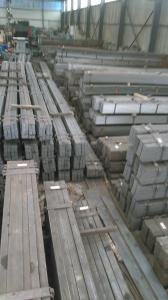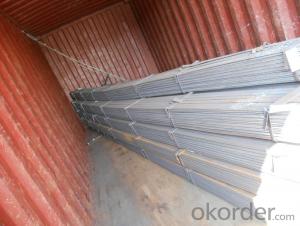Flat Steel Bars Grade SS400 ASTM A36
- Loading Port:
- Tianjin
- Payment Terms:
- TT or LC
- Min Order Qty:
- 50 m.t.
- Supply Capability:
- 10000T m.t./month
OKorder Service Pledge
OKorder Financial Service
You Might Also Like
Product Description:
OKorder is offering Flat Steel Bars Grade SS400 ASTM A36 at great prices with worldwide shipping. Our supplier is a world-class manufacturer of steel, with our products utilized the world over. OKorder annually supplies products to African, South American and Asian markets. We provide quotations within 24 hours of receiving an inquiry and guarantee competitive prices.
Product Applications:
Flat Steel Bars Grade SS400 ASTM A36 are ideal for structural applications and are widely used in the construction of buildings and bridges, and the manufacturing, petrochemical, and transportation industries.
Product Advantages:
OKorder's Flat Steel Bars Grade SS400 ASTM A36 are durable, strong, and wide variety of sizes.
Main Product Features:
· Premium quality
· Prompt delivery & seaworthy packing (30 days after receiving deposit)
· Can be recycled and reused
· Mill test certification
· Professional Service
· Competitive pricing
Product Specifications:
Manufacture: slited
Slitting precision (width) : 0.5 mm or less
Raw material: Q235B, Q345B, Q235-1 b
crosscutting precision (length) : 2 mm or less
Processing: the thickness of 2.0-16 mm;
Shear length: 2000 mm above
Wide degree: 15-1250 - mm;
Leveling precision: 1-2 MM square
Packaging: Export packing, nude packing, bundled
FAQ:
Q1: How many tons of steel products could be loaded in containers?
A1: Usually the steel products are delivered by bulk vessel because of the large quantity and the freight. However, there are no bulk vessel enter some seaports so that we have to deliver the cargo by containers. The 6m steel product can be loaded in 20FT container, but the quantity is changed according to the size, usually from 18tons to 25tons.
Q2: How do we guarantee the quality of our products?
A2: We have established an advanced quality management system which conducts strict quality tests at every step, from raw materials to the final product. At the same time, we provide extensive follow-up service assurances as required.
Q3: what is the difference between actual weight and theoretical weight?
A3: All the section steel has two weights: actual weight and theoretical weight. Actual weight is the weighing out when the product delivered from the mill. Theoretical weight is calculated by pieces. The invoice can be based on each of them as your request.
Images:
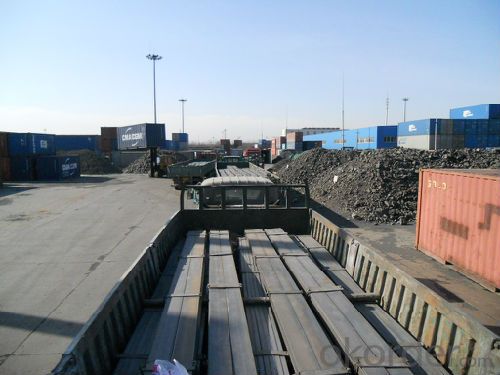
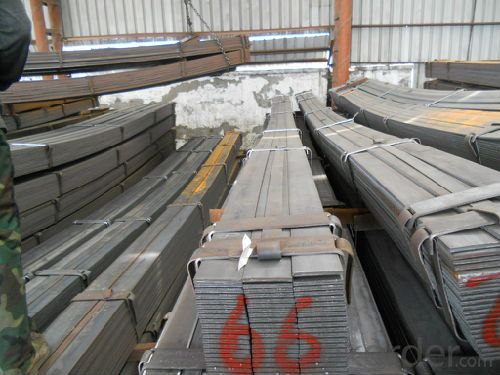
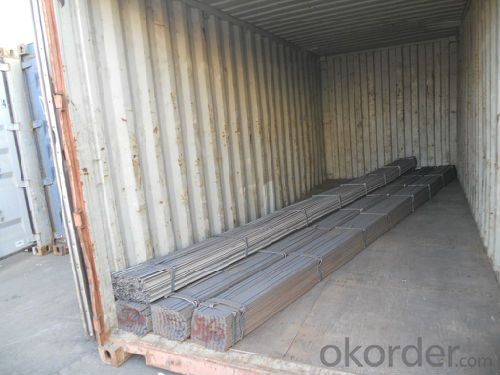
- Q:Can steel flat bars be used for creating architectural facades or cladding?
- Yes, steel flat bars can be used for creating architectural facades or cladding. Steel is a versatile and durable material that can be shaped and manipulated to create various architectural elements. Steel flat bars can be used to create sleek and modern architectural facades or cladding, providing a clean and contemporary aesthetic to buildings. The flat bars can be cut, welded, and installed in different configurations to achieve different design patterns and textures. Additionally, steel is known for its strength and resistance to weathering, making it an ideal choice for exterior applications. Overall, steel flat bars offer a wide range of design possibilities and can be effectively used to create striking architectural facades or cladding.
- Q:What is the price range of steel flat bars?
- Several factors, such as the size, grade, and quality of the steel, can cause the price range of steel flat bars to vary. Typically, the price range for these bars is between $10 and $100 per bar. However, specialty or high-grade steel flat bars may be priced even higher, going up to $200 or beyond. To obtain the most accurate and current pricing information, it is advisable to consult local suppliers or refer to online sources.
- Q:What are the safety precautions when working with steel flat bars?
- When working with steel flat bars, it is important to take certain safety precautions to minimize the risk of accidents or injuries. Some of the key safety measures include wearing personal protective equipment (PPE) such as safety glasses, gloves, and steel-toed boots to protect against potential hazards. Additionally, using appropriate lifting techniques or mechanical aids to handle heavy or large steel flat bars can prevent strain or back injuries. It is also crucial to ensure a well-ventilated work area to minimize exposure to fumes or dust generated during cutting, grinding, or welding processes. Regularly inspecting the flat bars for any defects or damage and properly securing them during transportation or storage is another important safety practice. Overall, following these safety precautions helps ensure a safer working environment when dealing with steel flat bars.
- Q:How do steel flat bars contribute to the overall safety of public structures?
- Steel flat bars contribute to the overall safety of public structures in several ways. Firstly, steel flat bars are incredibly strong and durable, making them an ideal material for constructing structural components such as beams, columns, and supports. This strength ensures that public structures can withstand various external forces such as heavy loads, wind, earthquakes, and other natural disasters, reducing the risk of collapse or damage. Additionally, steel flat bars have excellent fire resistance properties. Steel has a high melting point, and unlike other materials like wood or concrete, it does not combust or release toxic fumes when exposed to fire. This fire resistance capability provides an important layer of safety in public structures, allowing occupants to evacuate safely in case of a fire emergency. Moreover, steel flat bars are highly resistant to corrosion, which is vital for structures exposed to harsh weather conditions or environments with high moisture levels. Corrosion weakens the structural integrity of materials over time, leading to potential safety hazards. By using steel flat bars, public structures can withstand corrosion and maintain their strength and safety for an extended period. Another advantage of steel flat bars is their versatility and ease of installation. Steel is a highly adaptable material that can be fabricated into various shapes and sizes according to specific design requirements. This versatility allows engineers to create structures with complex geometries and optimize load-bearing capacities, ensuring the overall stability and safety of the public infrastructure. Lastly, steel flat bars have excellent seismic resistance properties, making them suitable for regions prone to earthquakes. The flexibility and ductility of steel allow it to absorb and dissipate seismic energy, reducing the impact of ground movements on the structure. This capability enhances the safety of public structures by minimizing the risk of structural failure during seismic events. In conclusion, steel flat bars play a crucial role in ensuring the overall safety of public structures. Their strength, fire resistance, corrosion resistance, versatility, and seismic resistance properties contribute to the durability, stability, and integrity of public infrastructure, providing a safe environment for the public to utilize and enjoy.
- Q:What are the different types of steel surface treatments available for flat bars?
- There are several types of steel surface treatments available for flat bars, each serving different purposes and providing various benefits. Some of the common types include: 1. Hot-dip galvanizing: This treatment involves immersing the flat bars in a bath of molten zinc, creating a protective coating that prevents corrosion. It provides excellent corrosion resistance and is often used in outdoor or marine applications. 2. Powder coating: Powder coating involves applying a dry powder to the surface of the flat bars and then heating it to form a durable and decorative coating. This treatment provides excellent resistance to chipping, scratching, and fading, making it suitable for applications where aesthetics and durability are important. 3. Electroplating: In electroplating, a thin layer of metal is deposited onto the surface of the flat bars using an electric current. Common metals used for electroplating include chrome, nickel, and zinc. This treatment enhances the appearance of the flat bars and provides corrosion resistance. 4. Passivation: Passivation is a chemical treatment that removes impurities and contaminants from the surface of the steel, improving its corrosion resistance. This treatment is commonly used for stainless steel flat bars to enhance their resistance to corrosion and staining. 5. Shot blasting: Shot blasting involves propelling small steel balls or other abrasive materials at high speeds onto the surface of the flat bars. This treatment removes rust, scale, and other impurities, creating a clean and textured surface that improves adhesion of coatings or paints. 6. Acid pickling: Acid pickling is a process where the flat bars are immersed in an acid solution to remove scale, rust, and other impurities from the surface. This treatment improves the appearance and cleanliness of the flat bars, making them more suitable for subsequent processes like painting or plating. It is important to choose the appropriate surface treatment based on the specific requirements of the application, such as the desired level of corrosion resistance, aesthetics, or durability. Consulting with a professional or a steel supplier can help determine the most suitable treatment for flat bars in a particular use case.
- Q:How do steel flat bars perform in terms of magnetic properties?
- Steel flat bars generally have magnetic properties due to their composition. Steel is an alloy of iron and carbon, and both iron and carbon have magnetic properties. In most cases, steel flat bars are made from mild steel, which contains a relatively low carbon content. Mild steel is known to exhibit ferromagnetic properties, meaning it can be attracted to a magnet. However, the magnetic properties of steel can vary depending on the specific composition and processing methods used to produce the flat bars. In some cases, alloying elements or heat treatment processes can be used to enhance or modify the magnetic properties. Therefore, while steel flat bars are typically magnetic, it is important to consider the specific type and composition of steel being used to determine its magnetic behavior accurately.
- Q:How do steel flat bars perform under cyclic loading conditions?
- Steel flat bars perform well under cyclic loading conditions due to their high strength and ductility. They are able to withstand repeated loading and unloading without experiencing significant deformation or failure. Additionally, the homogeneous nature of steel ensures consistent performance throughout the cyclic loading process, making it a reliable choice for structural applications.
- Q:What is the difference between hot-rolled and extruded steel flat bars?
- Hot-rolled steel flat bars are produced by heating a steel billet and passing it through a series of rolling mills, which shape the steel into the desired flat shape. This process results in a rougher surface texture and less precise dimensions compared to extruded steel flat bars. On the other hand, extruded steel flat bars are formed by forcing molten steel through a die to create the desired shape. This method produces a smoother surface finish and more consistent dimensions. Overall, the main difference between hot-rolled and extruded steel flat bars lies in the manufacturing process and the resulting surface quality and dimensional accuracy.
- Q:Can steel flat bars be heat-treated?
- Yes, steel flat bars can be heat-treated. Heat treatment involves heating the steel to a specific temperature and then cooling it rapidly or slowly to alter its properties such as hardness, strength, and toughness. This process can be used to improve the overall performance and durability of steel flat bars.
- Q:Can steel flat bars be used for making molds or dies?
- Yes, steel flat bars can be used for making molds or dies. Steel flat bars have excellent strength and durability, making them suitable for creating molds or dies used in various industrial applications.
1. Manufacturer Overview |
|
|---|---|
| Location | |
| Year Established | |
| Annual Output Value | |
| Main Markets | |
| Company Certifications | |
2. Manufacturer Certificates |
|
|---|---|
| a) Certification Name | |
| Range | |
| Reference | |
| Validity Period | |
3. Manufacturer Capability |
|
|---|---|
| a)Trade Capacity | |
| Nearest Port | |
| Export Percentage | |
| No.of Employees in Trade Department | |
| Language Spoken: | |
| b)Factory Information | |
| Factory Size: | |
| No. of Production Lines | |
| Contract Manufacturing | |
| Product Price Range | |
Send your message to us
Flat Steel Bars Grade SS400 ASTM A36
- Loading Port:
- Tianjin
- Payment Terms:
- TT or LC
- Min Order Qty:
- 50 m.t.
- Supply Capability:
- 10000T m.t./month
OKorder Service Pledge
OKorder Financial Service
Similar products
New products
Hot products
Related keywords

























